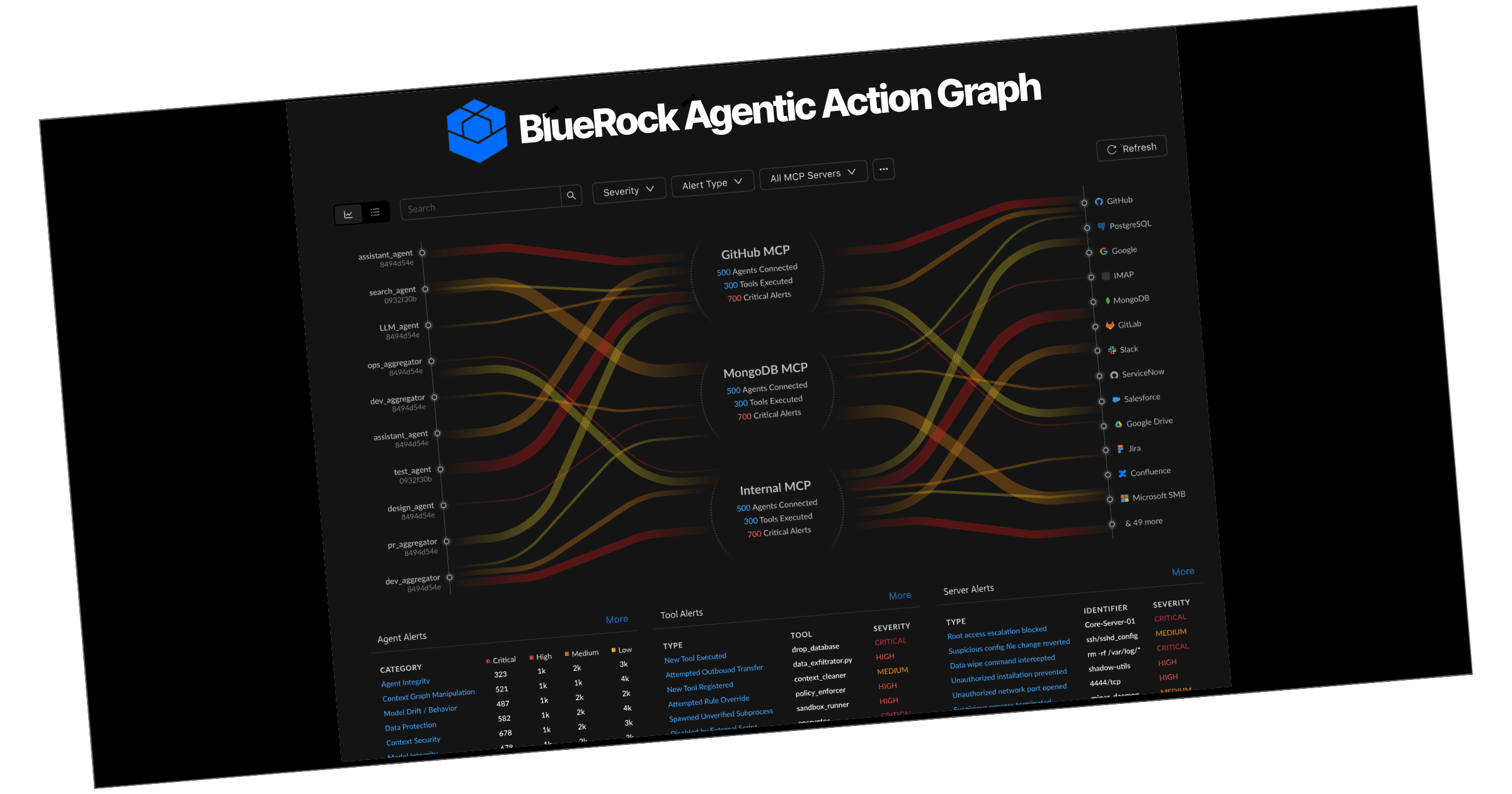Model Context Guardrails for Your MCP
See every action. Control the context.
STAY SAFE
for security teams
Gateways are blind.
See every action.
Control the context.
See Platform Demo
AI agents can read files, execute tools, issue system commands, and access sensitive data through MCP servers and external integrations. Most organizations can’t see these actions — and can’t stop dangerous ones before they execute. BlueRock solves this with a security stack purpose-built for agentic workflows: safe MCP server selection, real-time action graphing, agent sandboxing, and pre-execution guardrails built into the runtime.
Secure Actions, Not Prompts
Prompt inspection and MCP gateways miss what agents actually do. They see requests — not the 47 tool calls, 12 database accesses, and 3 code execution steps agents take to accomplish them.
This is the shift from Agentic Protection 1.0 to 2.0:
1.0: Inspect prompts, filter at the edge, easily bypassed
2.0: See and secure actions at runtime, pre-execution enforcement
BlueRock is Agentic Protection 2.0
Three Execution Boundaries Every Agent Crosses
Every agentic operation — and every real incident — maps to one of three boundaries:
TOOLS
Agents call MCP tools and custom integrations.
Risk: Calling destructive tools, passing unsafe parameters, using shadow MCP servers.
DATA
Agents access, read, transform, and move data.
Risk: Reading sensitive data without context, exfiltrating data, crossing dev → prod boundaries.
EXECUTION
Agents execute code: shell commands, subprocesses, file operations.
Risk: Spawning shells in prod, executing unvalidated code, privilege escalation.
The BlueRock Agentic Protection Platform
One platform. Visibility first, control when you're ready.
MCP Trust Registry
Know which MCP servers are safe before you connect. Security ratings, tool exposure mapping, remediation guidance. The only security-focused MCP registry.
Explore the Registry
Agent Sandbox 2.0
Isolate, observe, and safely run agents in minutes. Zero-change or one-line CLI. Safe experimentation with full action visibility.
Request Sandbox 2.0 Access
Agentic Visibility
See every agent action: tools → data → execution.
Unified action map, drift detection, MCP + agent telemetry correlation.
See the Agentic Action Map
MCP Server Protection
Block unsafe actions before they run (tools, data, execution). Tool governance, data access rules, execution guardrails. Pre-execution enforcement.
Learn How to Secure Actions
Choose safe MCP servers and tools before you connect.
The free MCP Server Registry scores servers, lists tools, and flags likely risks with remediation notes.
Scroll to see the full scan results.

Every agent path, every tool call, explained.
The BlueRock Agentic Visibility streams MCP + runtime events with policy outcomes. Search by agent, tool, resource, or path.
What you can do today
Deployment Options
Fast Mode (DevOps)
Launch BlueRock via a container or machine image.
In three minutes or less, agentic protection is running in an environment for developers to build their agentic workflows. Every instance/node running is default protected by BlueRock.
Flex Mode (Builders)
Build your agent or MCP server.
Launch Sandbox 2.0 via a single command-line and your agent is running inside or have an agent framework launch the sandbox. Launch your MCP server and get tool visibility and control. Devops can easily integrate the sandbox and/or MCP server into their CI/CD.
Compatibility
Agentic platforms: CrewAI, LangChain, Google ADK and many more
MCP servers: Python (now), Java (now), Node.js / TypeScript (Q1)
Infrastructure: AWS, Azure (Q1), GCP (Q1)
BlueRock Pre-Packaged Images: Amazon Linux 2023 v6.12, Ubuntu v24.x, Amazon Bottlerocket v1.43
Observability: Any OTEL-native event collector
IaC: Terraform, CloudFormation










